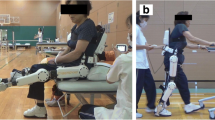Abstract
We studied newly developed assistive robot movement (ARM, HEXAR-KR40P) equipment, and compared with conventional continuous passive movement (CPM) equipment, focusing on range of motion (ROM) and strengthening of knee joint muscles. 110 osteoarthritis (OA) patients were recruited from five different clinics. At first, eighty patients were enrolled to evaluate the subjective satisfaction of ARM. Secondly, thirty patients were enrolled to find the effectiveness of ARM including ROM and strength compared with CPM. Subjects in first study performed exercise for two weeks. Exercise was performed with CPM and ARM for ten minutes alternately. Subjects in second study performed exercise with ARM only 30 min/day for two weeks, and measured ROM, strength, and functional changes. Obtained data was analyzed with Wilcoxon signed rank test. As a result, higher subjective satisfaction with ARM in patients and researchers survey was noted compared with CPM (p<0.05). Active and passive ROMs of knee flexion were significantly improved after ARM exercise. Strength of knee muscles, timed up and go test (TUGT), sit-and-stand-up of short physical performance battery (SPPB) score were also significantly improved after ARM exercise. Findings suggest that ARM equipment performed better than CPM equipment for knee OA patients to increase in ROM and strength.
Similar content being viewed by others
Abbreviations
- OA:
-
osteoarthritis
- TKR:
-
total knee joint replacement
- ARM:
-
assistive robot movement (HEXAR-KR40P)
- CPM:
-
continuous passive movement
- ROM:
-
range of motion
- BMI:
-
body mass index
- TUGT:
-
timed up and go test
- SPPB:
-
short physical performance battery
References
Felson, D. T., Naimark, A., Anderson, J., Kazis, L., Castelli, W., and Meenan, R. F., “The Prevalence of Knee Osteoarthritis in the Elderly. the Framingham Osteoarthritis Study,” Arthritis & Rheumatism, Vol. 30, No. 8, pp. 914–918, 1987.
Gamble, R., Wyeth-Ayerst, J., Johnson, E. L., Searle, W. A., and Beecham, S., “Recommendations for the Medical Management of Osteoarthritis of the Hip and Knee,” Arthritis & Rheumatism, Vol. 43, No. 9, pp. 1905–1915, 2000.
Dieppe, P., Basler, H., Chard, J., Croft, P., Dixon, J., et al., “Knee Replacement Surgery for Osteoarthritis: Effectiveness, Practice Variations, Indications and Possible Determinants of Utilization,” Rheumatology, Vol. 38, No. 1, pp. 73–83, 1999.
Dieppe, P., “Management of Osteoarthritis of the Hip and Knee Joints,” Current Opinion in Rheumatology, Vol. 5, No. 4, pp. 487–493, 1993.
Hochberg, M. C., Altman, R. D., Brandt, K. D., Clark, B. M., Dieppe, P. A., et al., “Guidelines for the Medical Management of Osteoarthritis,” Arthritis & Rheumatism, Vol. 38, No. 11, pp. 1535–1540, 1995.
Scott, D., “Guidelines for the Diagnosis, Investigation and Management of Osteoarthritis of the Hip and Knee. Report of a Joint Working Group of the British Society for Rheumatology and the Research Unit of the Royal College of Physicians,” Journal of the Royal College of Physicians of London, Vol. 27, No. 4, pp. 391–396, 1993.
O’Driscoll, S. W. and Giori, N. J., “Continuous Passive Motion (CPM): Theory and Principles of Clinical Application,” Journal of Rehabilitation Research and Development, Vol. 37, No. 2, pp. 179–188, 2000.
Guralnik, J. M., Simonsick, E. M., Ferrucci, L., Glynn, R. J., Berkman, L. F., et al., “A Short Physical Performance Battery Assessing Lower Extremity Function: Association with Self-Reported Disability and Prediction of Mortality and Nursing Home Admission,” Journal of Gerontology, Vol. 49, No. 2, pp. M85–M94, 1994.
O’Driscoll, S. W., Kumar, A., and Salter, R. B., “The Effect of Continuous Passive Motion on the Clearance of a Hemarthrosis from a Synovial Joint: An Experimental Investigation in the Rabbit,” Clinical Orthopaedics and Related Research, Vol. 176, pp. 305–311, 1983.
Rorabeck, C. H., “Continuous Passive Motion is a Useful Postoperative Tool,” Orthopedics, Vol. 22, No. 4, pp. 392–392, 1999.
Johnson, D., “The Effect of Continuous Passive Motion on Wound-Healing and Joint Mobility after Knee Arthroplasty,” The Journal of Bone & Joint Surgery, Vol. 72, No. 3, pp. 421–426, 1990.
Mclnnes, J., Larson, M. G., Daltroy, L. H., Brown, T., Fossel, A. H., et al., “A Controlled Evaluation of Continuous Passive Motion in Patients Undergoing Total Knee Arthroplasty,” The Journal of the American Medical Association, Vol. 268, No. 11, pp. 1423–1428, 1992.
Johnson, D. P. and Eastwood, D. M., “Beneficial Effects of Continuous Passive Motion after Total Condylar Knee Arthroplasty,” Annals-Royal College of Surgeons of England, Vol. 74, pp. 412–412, 1992.
Dorr, L. D., “Continuous Passive Motion Offers no Benefit to the Patient,” Orthopedics, Vol. 22, No. 4, 1999.
Pope, R. O., Corcoran, S., McCaul, K., and Howie, D. W., “Continuous Passive Motion after Primary Total Knee Arthroplasty Does it Offer any Benefits?” Journal of Bone & Joint Surgery, British Volume, Vol. 79, No. 6, pp. 914–917, 1997.
Lynch, A. F., Bourne, R. B., Rorabeck, C. H., Rankin, R. N., and Donald, A., “Deep-Vein Thrombosis and Continuous Passive Motion after Total Knee Arthroplasty,” The Journal of Bone and Joing Surgery, Vol. 70, No. 1, pp. 11–14, 1988.
Rat, A. C., Guillemin, F., Osnowycz, G., Delagoutte, J. P., Cuny, C., et al., “Total Hip or Knee Replacement for Osteoarthritis: Midand LongTerm Quality of Life,” Arthritis Care & Research, Vol. 62, No. 1, pp. 54–62, 2010.
Rosner, B., Glynn, R. J., and Lee, M. L. T., “The Wilcoxon Signed Rank Test for Paired Comparisons of Clustered Data,” Biometrics, Vol. 62, No. 1, pp. 185–192, 2006.
Trzeciak, T., Richter, M., and Ruszkowski, K., “Effectiveness of Continuous Passive Motion after Total Knee Replacement,” Chirurgia Narzadow Ruchu I Ortopedia Polska, Vol. 76, No. 6, pp. 345–349, 2010.
Boese, C. K., Weis, M., Phillips, T., Lawton-Peters, S., Gallo, T., and Centeno, L., “The Efficacy of Continuous Passive Motion after Total Knee Arthroplasty: A Comparison of Three Protocols,” The Journal of Arthroplasty, Vol. 29, No. 6, pp. 1158–1162, 2014.
Author information
Authors and Affiliations
Corresponding author
Rights and permissions
About this article
Cite this article
Kim, M.J., Lee, D.H., Kim, T. et al. Lower extremity exercise of knee osteoarthritis patients using portable assistive robot (HEXAR-KR40P). Int. J. Precis. Eng. Manuf. 15, 2617–2622 (2014). https://doi.org/10.1007/s12541-014-0635-z
Received:
Revised:
Accepted:
Published:
Issue Date:
DOI: https://doi.org/10.1007/s12541-014-0635-z




